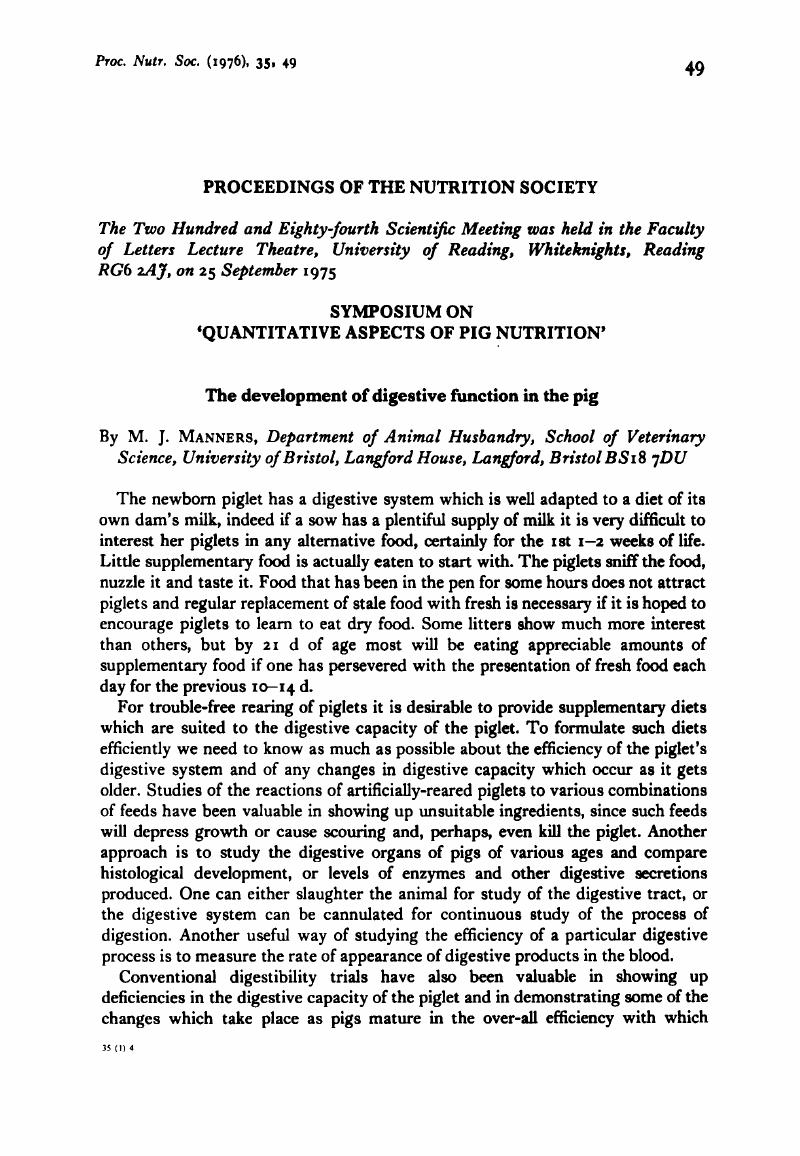Crossref Citations
This article has been cited by the following publications. This list is generated based on data provided by Crossref.
Decuypere, J. A.
Bossuyt, R.
and
Henderickx, H. K.
1978.
Gastric secretion in suckling pigs and early-weaned pigs given a dry cow's-milk formulaad lib..
British Journal of Nutrition,
Vol. 40,
Issue. 1,
p.
91.
Kirchgessner, M.
and
Roth, F. X.
1980.
Verdaulichkeit und Bilanz von Protein, Energie und einigen Mineralstoffen bei Fumarsäurezulagen an Ferkel.
Zeitschrift für Tierphysiologie Tierernährung und Futtermittelkunde,
Vol. 44,
Issue. 1-5,
p.
239.
Larkin, H.A.
and
Hannan, J.
1983.
Gastric structure and function in iron-deficient piglets.
Research in Veterinary Science,
Vol. 34,
Issue. 1,
p.
11.
Henry, R. W.
Pickard, D. W.
and
Hughes, P. E.
1985.
Citric acid and fumaric acid as food additives for early-weaned piglets.
Animal Science,
Vol. 40,
Issue. 3,
p.
505.
Trugo, N. M. F.
and
Newport, M. J.
1985.
Vitamin B12absorption in the neonatal piglet.
British Journal of Nutrition,
Vol. 54,
Issue. 1,
p.
257.
Broz, J.
and
Schulze, J.
1987.
Efficacy of citric acid as a feed additive in early weaned piglets.
Journal of Animal Physiology and Animal Nutrition,
Vol. 58,
Issue. 1-5,
p.
215.
Roth, F. X.
Kreuzer, M.
and
Kirchgessner, M.
1988.
Auswirkungen von freier Phosphorsäure als Zulage zu Alleinfuttermitteln für Ferkel und Mastschweine auf die Bilanzen an einigen Mineralstoffen (P, Ca, K, Na, Mg, Zn).
Journal of Animal Physiology and Animal Nutrition,
Vol. 59,
Issue. 1-5,
p.
247.
Münchow, H.
and
Häger, H.
1989.
Untersuchungen zur Einsatzwürdigkeit von unbehandeltem, HCl-behandeltem und teilhydrolysiertem Strohmehl im Fütterungsregime für Ferkel nach frühem Absetztermin.
Archiv für Tierernaehrung,
Vol. 39,
Issue. 8-9,
p.
703.
Eidelsburger, U.
Roth, F. X.
and
Kirchgessner, M.
1992.
Zum Einfluß von Ameisensäure, Calciumformiat und Natriumhydrogencarbonat auf tägliche Zunahmen, Futteraufnahme, Futterverwertung und Verdaulichkeit.
Journal of Animal Physiology and Animal Nutrition,
Vol. 67,
Issue. 1-5,
p.
258.
Jonsson, Eva
and
Conway, Patricia
1992.
Probiotics.
p.
259.
Ravindran, V
and
Kornegay, E T
1993.
Acidification of weaner pig diets: A review.
Journal of the Science of Food and Agriculture,
Vol. 62,
Issue. 4,
p.
313.
Yu, B.
and
Tsen, H.Y.
1993.
Lactobacillus cells in the rabbit digestive tract and the factors affecting their distribution.
Journal of Applied Bacteriology,
Vol. 75,
Issue. 3,
p.
269.
Kirchgessner, M.
Roth, F. X.
and
Paulicks, B. R.
1995.
Zur nutritiven Wirkung von Sorbinsäure in der Ferkelaufzucht.
Journal of Animal Physiology and Animal Nutrition,
Vol. 74,
Issue. 1-5,
p.
235.
Li, Defa
Che, Xiangrong
Wang, Yuqiong
Hong, Cao
and
Thacker, P.A
1998.
Effect of microbial phytase, vitamin D3, and citric acid on growth performance and phosphorus, nitrogen and calcium digestibility in growing swine.
Animal Feed Science and Technology,
Vol. 73,
Issue. 1-2,
p.
173.
Bedford, M. R.
and
Schulze, H.
1998.
Exogenous enzymes for pigs and poultry.
Nutrition Research Reviews,
Vol. 11,
Issue. 1,
p.
91.
Drescher, Karsten
Roos, Nils
Pfeuffer, Maria
Seyfert, Hans-Martin
Schrezenmeir, Jürgen
and
Hagemeister, Hans
1999.
Recovery of 15N-Lactoferrin Is Higher Than That of 15N-Casein in the Small Intestine of Suckling, But Not Adult Miniature Pigs.
The Journal of Nutrition,
Vol. 129,
Issue. 5,
p.
1026.
TSILOYIANNIS, V.K.
KYRIAKIS, S.C.
VLEMMAS, J.
and
SARRIS, K.
2001.
The effect of organic acids on the control of post-weaning oedema disease of piglets.
Research in Veterinary Science,
Vol. 70,
Issue. 3,
p.
281.
TSILOYIANNIS, V.K.
KYRIAKIS, S.C.
VLEMMAS, J.
and
SARRIS, K.
2001.
The effect of organic acids on the control of porcine post-weaning diarrhoea.
Research in Veterinary Science,
Vol. 70,
Issue. 3,
p.
287.
Meunier, J.-P.
Cardot, J.-M.
Gauthier, P.
Beyssac, E.
and
Alric, M.
2006.
Use of rotary fluidized-bed technology for development of sustained-release plant extracts pellets: Potential application for feed additive delivery1.
Journal of Animal Science,
Vol. 84,
Issue. 7,
p.
1850.
Cervantes, M.
Gómez, R.
Fierro, S.
Barrera, M. A.
Morales, A.
Araiza, B. A.
Zijlstra, R. T.
Sánchez, J. E.
and
Sauer, W. C.
2011.
Ileal digestibility of amino acids, phosphorus, phytate and energy in pigs fed sorghum-based diets supplemented with phytase and Pancreatin®.
Journal of Animal Physiology and Animal Nutrition,
Vol. 95,
Issue. 2,
p.
179.



